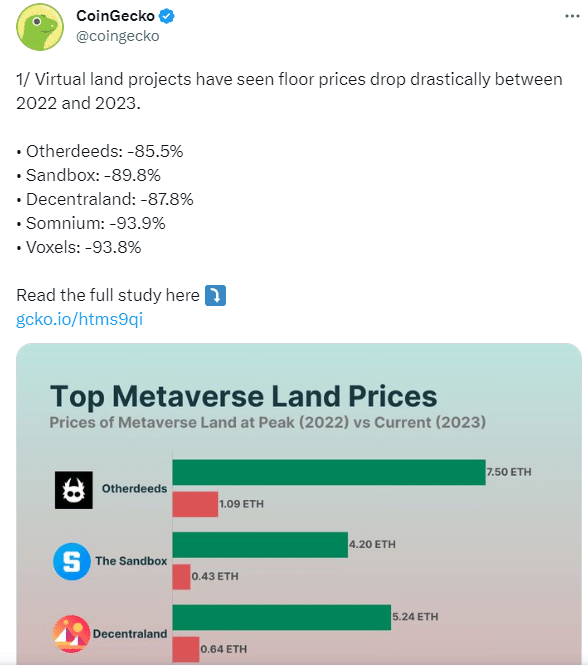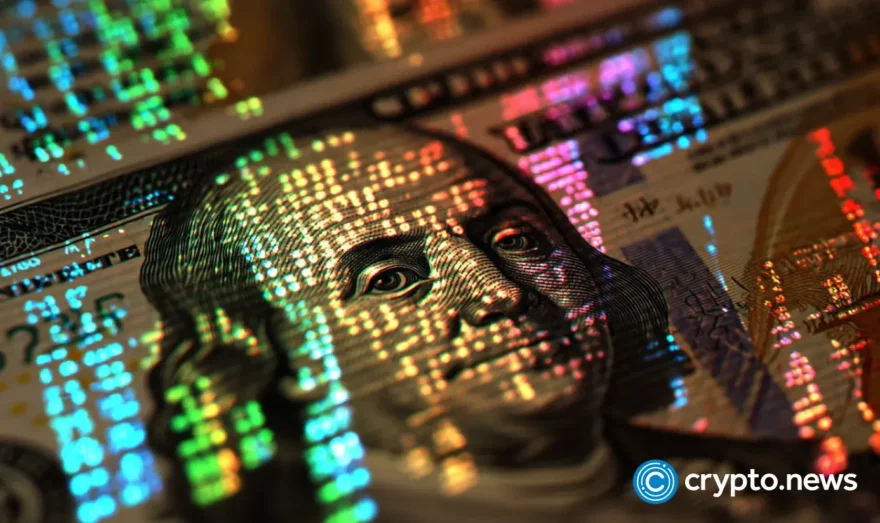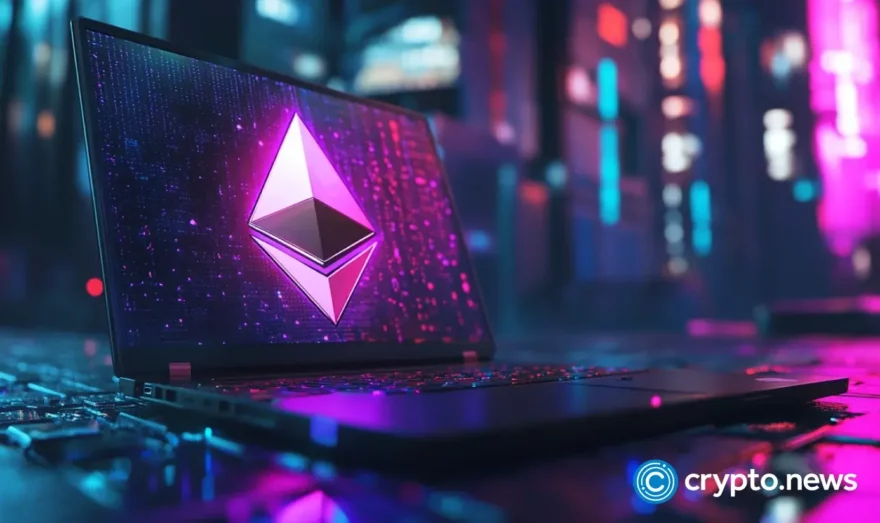Virtual land NFT prices crater as crypto winter bites

Virtual land metaverse projects such as Decentraland, Voxels, The Sandbox, and others, have experienced a significant plunge in floor prices of their NFTs between 2022 and 2023.
The move down left digital collectible and non-fungible token (NFT) enthusiasts questioning the future of the digital real estate market.
Metaverse enthusiasm fading
A new study conducted between Jan. 2022, and May 2023, reveals a stark reality for virtual land projects. The study examined the price fluctuations of the top five metaverse lands at their peak and current prices in ether (ETH), shedding light on the changing dynamics of the metaverse landscape.
During the height of the NFT craze, the floor prices of metaverse lands reached high levels. Otherdeeds, developed by OthersideMeta, commanded a price of 7.50 ETH on May 1, 2022, making it the most expensive virtual land collection.
It was closely followed by SomniumSpace, which traded at 6.05 ETH at the beginning of 2022. Decentraland secured the third position with a collection valued at 5.24 ETH.
Fast forward to May 24, 2023, and a significant transformation has occurred. The metaverse land market has experienced a drastic decline, with floor prices tumbling across various projects.
Today, metaverse land can be acquired for prices ranging from 0.37 to 1.09 ETH, depending on the project, the study reveals.
Surprisingly, Otherdeeds, developed by Yuga Labs, the creators of the renowned Bored Ape Yacht Club (BAYC) NFTs, still claims the top spot for the most expensive metaverse land collection.
However, the current price has fallen to 1.09 ETH, representing a significant decrease from its peak value. Decentraland follows, currently trading at 0.64 ETH.
The cheapest land in the metaverse can be found in Voxels, with parcels priced at 0.16 ETH. This collection encompasses 7,930 parcels of land, each possessing distinct characteristics, including size and location. Somnium Space and The Sandbox follow suit, with respective prices of 0.37 ETH and 0.43 ETH.

Somnium Space suffered the largest decline, plummeting by a whopping 93.9% from its peak value. Voxels experienced a similar fate, with a decline of 93.8%. The Sandbox, Decentraland, and Otherdeeds also faced significant losses, dropping by 89.8% and 85.5% respectively.
Possible reasons for virtual land price declines
Several factors can be cited to the drastic drop in virtual land prices.
Firstly, the initial hype surrounding NFTs and metaverse lands created an inflated market where prices were driven up by speculation and fear of missing out (FOMO). As the market cooled down and investor sentiment shifted, prices fell.
Moreover, the increasing supply of virtual lands played a role in the price decline.
With more metaverse projects emerging and offering their own land collections, the market became saturated, diluting the value of individual projects. Additionally, some early adopters and speculators may have decided to cash out their investments, putting downward pressure on prices.
The maturing of the metaverse industry also played a part in the price drop.
As the technology and infrastructure behind virtual worlds improved, newer and more innovative projects entered the scene. This increased competition compelled existing projects to reassess their value propositions and adjust their pricing accordingly.
Implications for the metaverse
The significant decrease in virtual land prices raises questions about the long-term viability and sustainability of the metaverse as a digital economy. Some critics argue that the speculative frenzy surrounding NFTs and virtual lands created an unsustainable bubble, and the price correction is a natural consequence of market dynamics.
However, proponents of the metaverse believe that the drop in prices presents an opportunity for wider adoption and accessibility.
Lower entry barriers can attract a broader audience and foster more diverse and inclusive virtual communities. As prices become more affordable, individuals who were previously priced out of the market may now have a chance to participate and contribute to the metaverse’s growth.
Furthermore, some argue that the price decline may lead to increased innovation and creativity within the metaverse ecosystem.
Developers and creators will be motivated to deliver unique and engaging experiences to differentiate their projects and attract users. This competition could drive the evolution of the metaverse, offering users more immersive and interactive environments.
Virtual land: pros and cons
Virtual land represents digital real estate within the metaverse, offering users the ability to own and customize their own parcels of the virtual world. These parcels are minted as non-fungible tokens and can be bought, sold, and traded on NFT marketplaces.
Owning virtual land grants users the privilege to host events, build digital assets, socialize with others, and explore various utilities within the metaverse.
Virtual land provides creators with an innovative canvas to express their ideas, enabling the development of unique experiences and digital assets. These creations can be monetized through various means, such as selling virtual goods, hosting events, or even offering services within the metaverse.
The metaverse, including virtual lands, has witnessed remarkable growth and investment interest from both individuals and businesses.
As the metaverse expands, the value of virtual land has the potential to appreciate significantly, providing early adopters with attractive returns on their investments. The evolving nature of the metaverse offers an opportunity for market growth and substantial returns.
Despite the massive advantages mentioned above, virtual land ownership has its fair share of risks, including market volatility, platform hacks, network downtimes, and others.
Looking ahead
While the current state of the metaverse land market reflects a significant drop in prices, it is important to approach these developments with a balanced perspective. The metaverse is a nascent and rapidly evolving industry, and price fluctuations are to be expected as the market matures.
Investors and enthusiasts should carefully consider the fundamentals, community engagement, and development roadmap of metaverse projects before making any investment decisions. Thorough research and due diligence are essential to navigate this evolving landscape successfully.
As the metaverse continues to capture the imagination of people worldwide, virtual land projects will remain a focal point of interest and investment. The future of the metaverse will depend on the collective efforts of developers, creators, and users to shape an immersive, vibrant, and sustainable digital realm.
The drastic drop in virtual land prices between 2022 and 2023 highlights the volatility and evolving nature of the metaverse market. While some may view the price decline as a setback, others see it as an opportunity for wider adoption and increased innovation.















